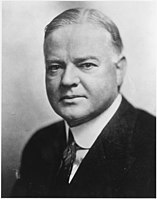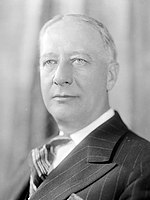| ||||||||||||||||||||||||||
All 29 Illinois votes to the Electoral College | ||||||||||||||||||||||||||
|---|---|---|---|---|---|---|---|---|---|---|---|---|---|---|---|---|---|---|---|---|---|---|---|---|---|---|
| ||||||||||||||||||||||||||
 County Results
| ||||||||||||||||||||||||||
| ||||||||||||||||||||||||||
| Elections in Illinois |
|---|
 |
Republican candidate Herbert Hoover won the state of Illinois in the 1928 United States presidential election, and would emerge victorious from the overall election. State voters chose 29 representatives, or electors, to the Electoral College, who voted for president and vice president.
A strongly Democratic state during the Second Party System, Illinois became Republican-leaning after the American Civil War due to a combination of strong Free Soil Party heritage amongst its Yankee northern counties with the wartime conversion of some Virginian-settled rock-ribbed Democratic Southern Illinois counties[1] to Unionist Republicanism[2] à la Appalachia.[3] Between the Civil War and World War I, partisanship in Illinois – like in the Border States – largely re-fought the war, with the result that although the Democratic Party gained at least 43 percent of the statewide vote via Southern and German Catholic support in every election up to 1900, they never gained an absolute majority and carried the state's electoral votes only in 1892.[4]
Due to the Democratic Party's growing Populist and prohibitionist leanings, a decline in Democratic support after 1900 in its German Central Illinois strongholds transformed Illinois into a powerfully Republican state at all levels.[5] Even Woodrow Wilson in 1912 when the GOP was mortally divided carried the state by only a very narrow margin, and in 1920 hostility to the League of Nations and the perceived anti-German bias of both outgoing President Wilson and new Democratic nominee and former Ohio Governor James M. Cox – the latter of whom had banned German-language instruction in Ohio schools[6] – meant Harding carried Illinois by over 42 percentage points and the state was his sixth strongest in a national landslide. Thirteen German Catholic or southern-settled counties went Republican for the first time.[7]
In 1924, Calvin Coolidge maintained Harding's dominance despite losing substantial German Catholic and Mississippi Valley industrial support to Progressive Wisconsin Senator Robert M. La Follette, whose family would endorse Catholic New York City Democrat Al Smith after the patriarch died in 1925.[8] Despite some predictions of upheaval during April[9] Hoover was easily nominated as the Republican candidate. Smith was nominated as the Democratic candidate. After the nominations were finalized, some critics felt Smith might have a chance of carrying electoral-vote-rich Illinois due to opposition to Hoover in the Farm Belt;[10] however by the end of June Hoover asserted that the farm vote was safe after Lowden's supporters decided to aid the GOP nominee.[11]
Hoover campaigned in Illinois after reports early in July[12] suggested the popularity of Smith's “wet” stand in Chicago made his win in this traditionally Republican state doubtful.[13] Smith did not visit the state during the summer, but relied on campaigning by members of the state Democratic ticket led by Thomas S. Donovan,[14] mainly in Chicago but also in the Metro East region.[15] During September, Donovan and the Democrats intensified their campaign in both liberal and anti-Prohibition Chicago and “dry” downstate Illinois.[16]
At the end of the summer, the state was confused and few trends were apparent in early polling, with Republicans in metropolitan Chicago quarreling bitterly.[17] However, by the end of September it was clear that religion was the paramount issue in the campaign and that it was driving Chicago toward Smith and the rest of the state toward Hoover (Smith was the first Catholic nominated by a major party for president).[18]
Despite earlier doubts,[13][14] the earliest poll by Literary Digest showed Hoover carrying Illinois by a two-to-one majority;[19] however, increased registration in Cook County made the early Literary Digest polls seem dubious,[20] and Hoover was winning only by five-to-three in the next poll in the second week of October,[21] and only by twelve percentage points in the third week – at a time when Hoover was leading in 42 of 48 states.[22] As things turned out, this last poll proved accurate. Smith would give his final Chicago campaign speech on October 17.[23]
- ^ Phillips, Kevin P.; The Emerging Republican Majority, pp. 341-344 ISBN 978-0-691-16324-6
- ^ Wells, Damon; Stephen Douglas: The Last Years, 1857–1861, p. 285 ISBN 0292776357
- ^ Copeland, James E.; ‘Where Were the Kentucky Unionists and Secessionists’; The Register of the Kentucky Historical Society, volume 71, no. 4 (October, 1973), pp. 344-363
- ^ "Presidential General Election Results Comparison – Illinois". Dave Leip’s U.S. Election Atlas.
- ^ Schattschneider, Elmer Eric; The Semisovereign People: A Realist's View of Democracy in America, pp. 76-84 ISBN 0030133661
- ^ Hough, Jerry F.; Changing Party Coalitions: The Mystery of the Red State-Blue State Alignment, pp. 86-87 ISBN 0875864090
- ^ Menendez, Albert J.; The Geography of Presidential Elections in the United States, 1868-2004, p. 52 ISBN 0786422173
- ^ Menendez; The Geography of Presidential Elections in the United States, p. 59
- ^ Dudle, Uncle; ‘The Lowden Revival’; Daily Boston Globe, April 17, 1928, p. 22
- ^ ‘The Pivotal State’; The Washington Post, June 11, 1928
- ^ ‘Hoover Will Have Aid of Lowden Men in His Campaign: Kansas City "Coalition" Chiefs Promise Their Support – Lowden Himself Silent’; The New York Times, July 1, 1982, p. 1
- ^ ‘Hoover Drive Begun to Hold Illinois: Deneen Tells State Chiefs Democrats “Poison” Minds of Some Industrial Leaders’; The New York Times, July 10, 1928, p. 1
- ^ a b ‘Celler Reports Smith Strong in Midwest: Representative Tells of Train Polls on His Trip Back From Houston’; The New York Times, July 8, 1928, p. 20
- ^ a b ‘Illinois for Smith, Says State Chairman: Donovan Telegraphs Raskob That the Democratic Sentiment “Is a Revelation”’; The New York Times, August 2, 1928, p. 2
- ^ ‘Plan Smith Campign Outside of Chicago: Hawes and Donowan Want Headquarters at St. Louis for Down-State Illinois’; The New York Times; August 16, 1928, p. 10
- ^ ‘Democrat Attack Telling in Illinois: State Is Called Extremely Doubtful as Assaults Hit G.O.P. Strongholds’
- ^ ‘Voters of Illinois Confused on Issues: No Definite Trend Yet Seen; G.O.P. in Bitter Quarrel in Chicago’; The Washington Post, September 2, 1928, p. M6
- ^ Hennessy, M.E.; ‘Religion Tops Issues in Battle in Illinois: Chicago Strong for Smith Rest Is for Hoover. Mid-West Republican Bureau Lays Claim to That Whole Section’; Daily Boston Globe, September 27, 1928, p. 12
- ^ ‘Hoover Lead Gains in Digest Poll’; The New York Times; October 5, 1928, p. 2
- ^ Donegan, Arthur B.; ‘Illinois in Ferment in Big Finals Drives: Both Parties Impressed by Record Registration in Cook County. State Is Held in Doubt’; The Washington Post, October 7, 1928, p. M4
- ^ ‘Hoover Keeps Lead on Digest Ballots: Poll of Forty States Gives Him 1,201,869, Against 688,829 for Governor Smith’; The New York Times, October 12, 1928, p. 22
- ^ ‘Hoover Has 42 States in Poll: Four States Show Smith Majority and Two Considered Doubtful Total of 2,529,997 Returns’; The Wall Street Journal, October 19, 1928, p. 6
- ^ Gableman, Edwin W.; ‘Smith Sees Victory in States Visited: Arrives in Chicago for His Final Speech of the Present Tour. Missouri Is Optimistic’; The Washington Post, October 18, 1928, p. 2
© MMXXIII Rich X Search. We shall prevail. All rights reserved. Rich X Search


